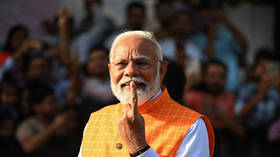Morgan Stanley bullish on India’s growth story

Morgan Stanley has upgraded India’s status to ‘overweight’ in its economic outlook. This move reflects a positive view of the world’s fifth-largest economy, even amid global headwinds caused by persistent inflationary pressures and geopolitical challenges. China has been downgraded to ‘equal-weight’ in the same assessment.
The brokerage expects the Indian economy to perform better in the future, despite global uncertainties. In a note released on Wednesday, the firm pegged India’s year-on-year growth through the decade, ending 2030, at 6.5%, compared to China’s 3.9%, BQ Prime reports.
Morgan Stanley highlighted the reformist policies of Narendra Modi’s government, a macro-stability agenda that supports strong capital expenditure, and New Delhi’s ability to leverage “multi-polar world dynamics.”
The upgrade of India’s status comes three months after Morgan Stanley elevated India from ‘underweight’ to ‘equal weight’, citing its resilient economy. India has also jumped from sixth to first in the ranking among emerging economies, including China, Brazil, Indonesia, South Korea, Mexico, and Türkiye.
“India rises from 6 to 1 in our process, with relative valuations less extreme than in October, and India’s ability to leverage multipolar world dynamics is a significant advantage,” the brokerage said in a statement. “India is arguably at the start of a long wave boom at the same time as China may be ending one.”
Morgan Stanley noted that the Indian economy is benefitting from a surge in inward foreign direct investment, including from the US, Taiwan, and Japan. It also hailed India’s improved export infrastructure echoing the Modi-led government’s infrastructure push, including more efficient ports, roads, and electricity networks.
Ridham Desai, managing director at Morgan Stanley India, weighed in on India’s robust growth story, noting that the country has experienced many changes in less than a decade, including supply-side policy reforms such as a build-up in infrastructure, formalization of the economy, change in real estate regulations, digitalization of payments, a new bankruptcy law coupled with a sharp decline in corporate balance sheet leverage.
The firm added that India is seeing a favorable demographic trend, while China has seen a decline in the working-age population since the early part of the last decade. According to People Research on India’s Consumer Economy (PRICE) and India’s Citizen Environment, a nonprofit think tank, India’s growth story is driven by a booming middle class of over 432 million (2020-21) which is likely to reach 715 million, or 47% of its total population, by 2030.
Morgan Stanley also upgraded specific sectors in India, including industrials, financials, and consumer discretionary stocks, which are now rated as ‘overweight’.
However, the brokerage flagged several key downside risks for the Indian market, including volatility due to inflation and rapid changes in the central bank’s monetary policies could have adverse effects, if productivity improvements fail to keep up with the growth momentum. The potential disruptive impact of artificial intelligence on India’s services exports and the labor force, which is estimated to be upwards of 435 million, remains a key concern, the analysts said.













